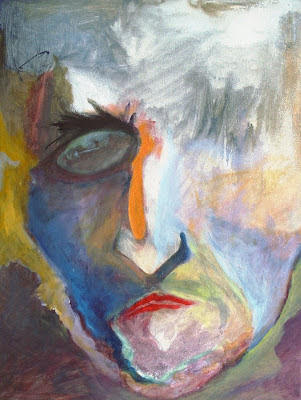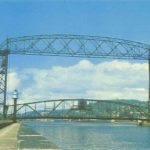Encounter with the Ennyman
Ed Newman interviews several local artists and writers a month at his blog, Ennyman’s Territory. So I thought I’d return the favor.
SECTION ONE: Roots in the Northland
David Beard: Ed, you are one of the most thoroughly connected creators in the Northland — working at the center of the literary and artistic communities. How would you describe your roots in the Northland — how far back do they go, and how wide do they spread?
EN: Hardly the most thoroughly connected, but I do intersect with a wide variety of people in both the business sector and arts sectors. I came to Duluth in 1986 and joined the Ad Club with the very deliberate aim of becoming connected to potential employment. Inasmuch as I felt a personal sense of calling as a writer, I joined a writers group at that time as well and initiated friendships that continue to this day. I paid special attention to the varieties of ways the written word was being utilized in this region and also noted who the other writers were.
When the internet emerged it was a pure delight because I discovered I could connect with like-minded people throughout the world. In the mid-nineties I had a column in Printwear Magazine called Screen Net in which I educated people on this emerging technology. My columns covered themes like “What is a Browser” and “What is a Search Engine” and “How Does eMail Work?” My first email respondent was a man who grew up in Tunisia but worked in Japan for Hitachi. It was thrilling to see how small the world was becoming. He remembers when as an eight-year-old the American armies passed through his town during WW2. I like to imagine that my father-in-law was one of the GIs who gave him candy. Later, when I created my Ennyman’s Territory blog, I interviewed artists from all over the world.
How wide do my roots spread? Global and local, and fairly deep into the grass roots arts scene of which I am a part here.
DB: How does your participation in these diverse communities inflect your own work as a writer? As a visual artist?
EN: As a writer I’ve gained a lot of encouragement and support from others, both writers and artists. I’d like to believe I have also been an encouragement and help to others who have shared some of their work with me, which I also find rewarding.
As a visual artist it has been satisfying to discover how many venues there are for artists able and willing to put themselves out there. Knowing your work is going to be displayed to a larger public challenges you to push your efforts to a higher level.
SECTION TWO: Arts Journalist
DB: Many Northlanders come to know you as an arts journalist first — as the creator of Ennyman’s Territory (a blog that, among other things, reviews local arts events and interviews local artsists) and as a columnist in the Reader covering the local arts scene. What drives you to document arts in Superior and Duluth?
EN: I’ve had a column in the National Oil & Lube News for fifteen years as a result of my affiliation with (employment by) Amsoil Inc. in Superior, and have published articles on various facets of the internet and eCommerce over the years, in addition to other themes.
There are probably two things that pushed me into arts journalism. First off, I enjoy interviewing people, finding out what makes them tick, sharing their life lessons with others, showing readers the kinds of ways creative people express themselves and how they balance life and work. I had been interviewing artists from other countries and continents whom I met through Twitter when one of these, Portuguese artist Margarida Sardinha, suggested that these interviews were one of the most significant things I was doing on my blog. The second motivation has been due to the discovery of how underserved the visual arts community has been in the Northland. Though the Trib has helped a lot of us know many of the activities that are happening in our region and introduced us to people doing interesting things, there is a whole realm of grass roots activity that never touches their radar. I believe this is what led Bob Boone to ask me to write my column for the Reader, his motivation in part being to compete with the DNT and fill a gap.
DB: Speaking locally, what interview surprised you most?
EN: Every interview surprises you in one way or another. Two that come most readily to mind were my interviews with Ann Klefstad and Tonya Borgeson. Ann has a remarkable depth that floors me every time I ask her anything, so much so that I actually thought we should collaborate on a book together. She has a brilliant mind in addition to being a talented artist.
Tonya Borgeson also surprised me as well. Maybe only because I pegged her a certain way and she comes across as so natural and “ordinary” in some ways, and then when you probe you discover this breadth of experience, this natural giftedness and the connections she’s developed beyond our region.
DB: Speaking locally, what art opening or performance has given you the most to think about in your own creative work?
EN: Looking back, I think the student show at the European Bakery in May 2011 produced an impact on the overall arts scene that has been catalytic. Here were ten UMD art students who took an abandoned space and transformed it into something memorable by means of their energy and imagination. Seeds for the future PRØVE Collective were planted by the success of this event.
DB: Part of this impulse comes from previous work interviewing national figures in arts and literature — can you tell us about Joe Petro and Kurt Vonnegut?
EN: I’ve actually been interviewing people since the early 1980s when I began pursuing what I believed was my “calling” as a writer. Interviewing people is a great privilege because you get to probe areas within other people that often are not accessible in polite conversation. Rod Stewart once sang “Every Picture Tells A Story” and I would suggest that every person has a story. The interviewer’s task is to unearth it. This probably takes as much skill as the presenting of it in written form.
Shortly after moving to Duluth I was contacted by the editor of a magazine to interview Congressman Oberstar and his opponent in the 1988 election. He met me at his office in Chisholm, probably to size me up. After fifteen minutes he said, “Why don’t you come over to the house and you can meet my mother and daughters.” We spent more than an hour there and then went to Iron World (now the Minnesota Discovery Center) for another hour. I was struck by the manner in which he subtly changed from son and father into public politician while I was with him, shaking hands with everyone as if he knew them. I must not have been the first person to ask what his greatest weakness was because he had a ready answer. “Chocolate.”
Joe Petro was an artist and screen printer from Lexington, Kentucky, whose excellent work and connections brought him in touch with a number of high profile celebrities. One day, because I was a fan of Jonathan Winters while growing up, I Googled Jonathan Winters to see what would come up and discovered Winters was also an artist. Some of his work had been screen printed by a man named Joe Petro. I was working at Chromaline at the time (now Ikonics) and was familiar with the editors of the leading magazines in the screen print industry. I called the editor of Screen Printing and pitched a story on Winters, but he suggested the Joe Petro piece in response because eight or ten years earlier they had done something on him and it would be a good follow up.
Petro’s clients included Ralph Steadman (who illustrated Hunter S. Thompson’s Fear and Loathing in Las Vegas), Kurt Vonnegut and Jonathan Winters and I was given access to each of these for interviews. I called Kurt Vonnegut in his home on a Sunday afternoon. He was in his living room watching a New York Giants game which was playing in the background. to be continued…
Recommended Links:
Leave a Comment
Only registered members can post a comment , Login / Register Here















2 Comments
[email protected]
about 12 years ago[email protected]
about 12 years ago